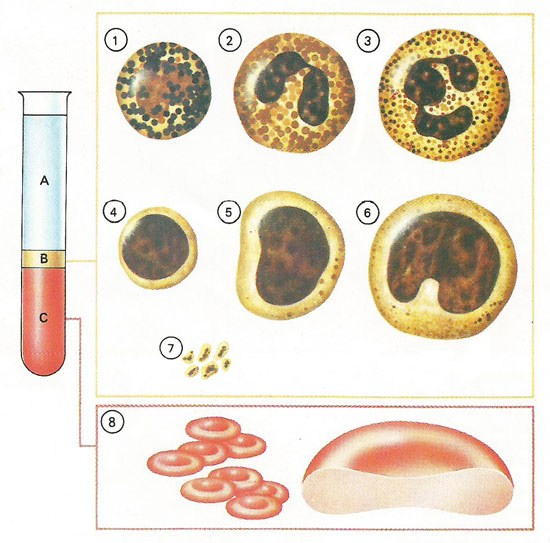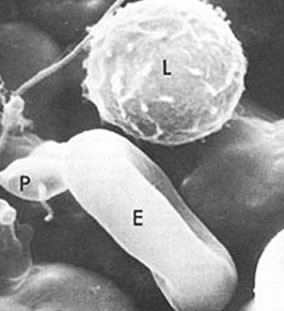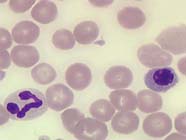blood

Spun in a high-speed centrifuge, blood separates out into plasma (A), layers of white cells and platelets (B), and red cells (C). Fluid plasma, almost 90% water, contains salts and proteins. Three main types of white cells, shown in magnification, are granulocytes (1-3), small and large lymphocytes (4,5), which are involved in the body's defences, and monocytes (6). Platelets (7) are vital clotting agents. Red cells (8) are the most numerous.

Constituents of blood. L is a lymphocyte or white blood cell. E is an erythrocyte or red blood cell. P is a blood platelet. Credit: NASA.

Red and white blood cells. The white blood cells are the larger ones with irregular nuclei. The small particles are platelets. Credit: US National Institutes of Health.
Blood is a fluid that circulates through the tissues of an animal's body, bringing oxygen, nutrients, and hormones to the cells, and carrying away waste products to be excreted. In warm-blooded organisms, it also plays an important role in maintaining a uniform body temperature. Blood travels through various types of blood vessels.
Components of blood
Suspended in the watery plasma of blood are seven types of cells and cell fragments: red blood cells (erythrocytes), white blood cells (leukocytes), and platelets. White blood cells come in five varieties. Three of these – neutrophils, eosinophils, and basophils – have granules in their cytoplasm and so are known as granulocytes; the other two varieties – lymphocytes and monocytes – lack granules. All the various types of blood cells are produced in the bone marrow (some 1011 of them each day in an adult human) and arise from a single type of cell called a hematopoietic stem cell – an "adult" multipotent stem cell.
Oxygen-carrying capacity
Blood has an exceptionally high oxygen-carrying capacity. For example, a liter of mammalian blood can carry about 250 cubic centimetersof oxygen, compared to a mere 5 cm3 of oxygen that can be dissolved in a liter of ordinary seawater at the same temperature. This high oxygen-carrying capacity is made possible by the presence of a metal-containing pigment, which is attached as a prosthetic group to the blood's protein. The pigment combines reversibly with oxygen (to form oxyhemoglobin), picking it up in a lung or a gill and ferrying it to the cells before letting it go. This process works because the pigment combines with oxygen at high partial pressures, found within the organism's respiratory organ, then releases it at the comparatively low pressure within cells. The most widely-distributed blood pigment on Earth is hemoglobin (Hb). Several other pigments have been discovered in nature, which, while not as efficient as hemoglobin, are able to serve as adequate oxygen-transporters in certain environments.
How blood carries carbon dioxide
As blood passes through body tissues, the red blood cells pick up carbon dioxide, which is a waste product of cellular respiration. Most of the carbon dioxide combines, not with hemoglobin, but with water to form carbonic acid. An enzyme in red blood cells causes the carbon dioxide to combine with water very rapidly. Once the carbonic acid has been formed it splits into two parts. About 70% of the part containing the original carbon dioxide leaks out of the red blood cells into the plasma; the rest remains in the red cells.


